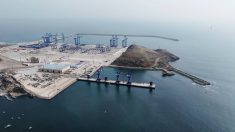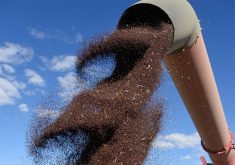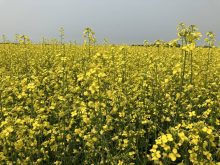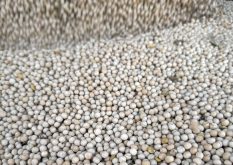A few Novembers ago, senior Canadian cabinet ministers headed to China with dozens of agriculture and other leaders in tow. They were filled with glowing visions of big new markets and a friendlier embrace than the United States was offering.
This November, Canadian Foreign Affairs Minister Melanie Joly and Prime Minister Justin Trudeau head to Southeast Asia with a new Asia-Pacific strategy in hand, one with a much darker view.
China “poses a geopolitical risk and the business community needs to know it,” Joly said in a Nov. 9 speech to the Asia Pacific Foundation and the Munk School of Global Affairs and Public Policy.
Read Also

Government, industry seek canola tariff resolution
Governments and industry continue to discuss how best to deal with Chinese tariffs on Canadian agricultural products, particularly canola.
“The China of 1970 (when Canada began normalizing relations with the communist giant) is not the China of today.”
Since then, China has gone from having a small, primitive and sluggish economy to having world-leading industries, an economy that might be the world’s biggest within a few years, and a giant, growing market of hungry middle-class consumers.
That should offer great prospects for Canada’s farmers, who produce exactly the sorts of high quality foods that China’s consumers increasingly demand. And for two decades China encouraged global integration and provided a friendly place for Canada to do business. Canadian exports to China have boomed, with greater sales expected as China continues to modernize and catch up with the western world.
It has become a huge market for canola, pork and most other products that Canadian farmers export. It’s often the largest market.
But China’s communist regime has taken a sharp turn to the dark side in recent years, as farmers know too well. It has used trade integration as a way of entangling countries like Canada, squeezing them and trying to use trade reliance as a means of coercing smaller players.
Canadian canola and pork were specific targets in China’s campaign of pressure and retribution for the 2018 arrest of Meng Wanzhou.
It is now acting in a more menacing manner with its neighbours, including India, Taiwan, Japan and the nations on the shores of the South China Sea. It has supported Russia regardless of its invasion of Ukraine.
It looks like our government has accepted that the earlier rosy visions of China’s potential for Canada have proven to be naïve, and a wary approach is more fitting. It’s a wariness that goes beyond caution and involves deliberate steps to push back against China’s aggressiveness.
Canada will strengthen its commitment to organizations of Asia-Pacific nations, including the Association of South East Asian Nations, to security partnerships like the “five eyes” intelligence network, and to trade with law-abiding nations like those in the Comprehensive and Progressive Agreement for Trans-Pacific Partnership.
With China, “we need to be clear-eyed,” said Joly.
Canada recently ordered three Chinese mining companies to sell their investments in Canadian companies that produce critical minerals for the electronics and electrification industries.
“There will be other sectors” affected by the new skeptical view on foreign ownership of crucial Canadian industries, said Joly. “We can’t be naïve.”
Foreign ownership by state-owned enterprises will draw particular scrutiny, she said.
China has used state-owned companies to take controlling interests in companies and facilities around the planet.
Joly vowed that Canada will continue to speak up on issues such as Uighur human rights, freedom of expression in Hong Kong and Taiwan’s security.
This is unlikely to please China, which has previously expressed outrage at what it considers foreign countries’ interference in its internal affairs.
Still, Joly said China’s enormous economy and role in Asian affairs can’t be ignored. Not only is the country a giant market for Canadian goods, and major supplier in the other direction, but working with China will be vital for tackling issues like climate change.
“We need to engage even when we disagree,” Joly said.
What does this mean for Canadian farmers? Most are in the enviable situation of exporting crops, meat and foods to China that China needs. Bulk commodity trade isn’t as reliant upon sophisticated supply chains as manufactured goods, and bulk goods can be more easily redirected from political hot spots in future disputes.
Canadian farmers often rely upon China-produced fertilizers and chemicals, as well as electronic components for much of today’s farm machinery and management systems. All sorts of products come from China’s vast array of factories.
There aren’t many easy alternatives to China if Canadian producers and exporters are encouraged to focus on other markets. It sounds great to suggest Canadians “diversify” their markets, but we’ve been doing that for decades. Selling more to China was a way to diversify Canadian trade away from the U.S. market. Other markets are smaller and often already developed.
Perhaps it won’t be easy to develop other foreign markets, but on the Canadian side of the export channel, there are definitely improvements that can be made.
Joly said “Canada has not always been a reliable partner” for foreign countries. That needs to be improved.
While she seemed to be speaking mostly about Canada’s participation in multilateral organizations and initiatives, Canadian agriculture could certainly agree that the reliability of Canada is a chronic problem when it comes to railway and port disruptions.
If Canada wants to build closer relationships with the smaller players in the Indo-Pacific region, the best way is to provide those players with what they need. Beyond diplomatic and military co-operation, being a secure supplier of food in an overheating world fits the bill perfectly.
If Canada is going to become less reliant upon China and less vulnerable to its actions, the federal government should ensure this country develops into the food exporting superpower it should be.
If we want to help our Asia-Pacific friends, we might need to fix things on this side of the ocean first.


















